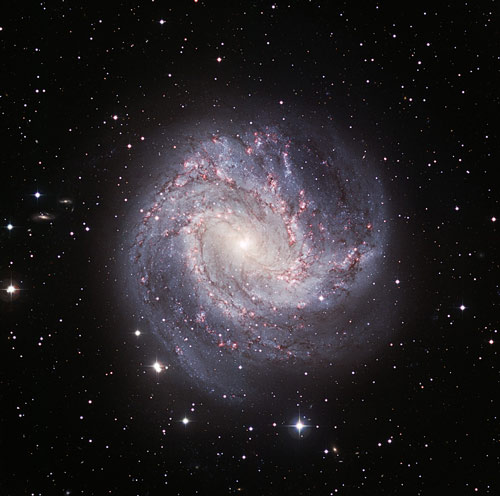Cosmic Source Hinted At for Galactic Magnetic Fields

Strange magnetic fields floating in distant expanses of space may help explain how galaxies end up being so magnetic, a new study has found.
Almost all galaxies have magnetic fields, but where they come from has been a mystery. Now astronomers have observed evidence of weak magnetic fields that could hold the answer.
"Basically we have found some magnetic fields which are in the middle of nowhere, outside galaxies and galaxy clusters and all other known structures," said researcher Andrii Neronov of the Geneva Observatory in Switzerland. "People have suggested that such fields should exist on theoretical grounds, but they have never been detected before."
Scientists think fields like these could be the precursors to the magnetic fields inside galaxies. But researchers still don't know how these first fields originate.
One idea suggests that they are created by protogalaxies, which are collections of matter on their way toward becoming galaxies. But another theory contends that the small magnetic fields are created even earlier, shortly after the birth of the universe.
The new observations favor this second idea, Neronov said.
In fact, Neronov and his team didn't so much see these fledgling fields, but rather the absence of certain kinds of light — which suggests they are there. The astronomers used the Fermi Gamma-ray Space Telescope, which was launched into Earth orbit in June 2008, to search for gamma-ray light coming from the hot plasma that floats between the galaxies — a material called the intergalactic medium.
Get the Space.com Newsletter
Breaking space news, the latest updates on rocket launches, skywatching events and more!
The researchers saw less of this radiation than they expected in places, which means that magnetic fields are likely deterring some of it.
"At the moment we have seen some negative effects," Neronov told SPACE.com. "We have seen some features which are due to the absorption of gamma-rays from distant sources."
Right now, there is still much uncertainty to their measurements, but the astronomers hope to collect more data to build up a better picture of these mysterious fields and how they act within galaxies.
The researchers report their discovery in the April 2 issue of the journal Science.
- Milky Way Galaxy: The Best of Your Images
- Distant Galaxies Unlock New Secrets of Dark Matter
- The Fermi Gamma-Ray Telescope Part 1, Part 2
Join our Space Forums to keep talking space on the latest missions, night sky and more! And if you have a news tip, correction or comment, let us know at: community@space.com.

Clara Moskowitz is a science and space writer who joined the Space.com team in 2008 and served as Assistant Managing Editor from 2011 to 2013. Clara has a bachelor's degree in astronomy and physics from Wesleyan University, and a graduate certificate in science writing from the University of California, Santa Cruz. She covers everything from astronomy to human spaceflight and once aced a NASTAR suborbital spaceflight training program for space missions. Clara is currently Associate Editor of Scientific American. To see her latest project is, follow Clara on Twitter.









